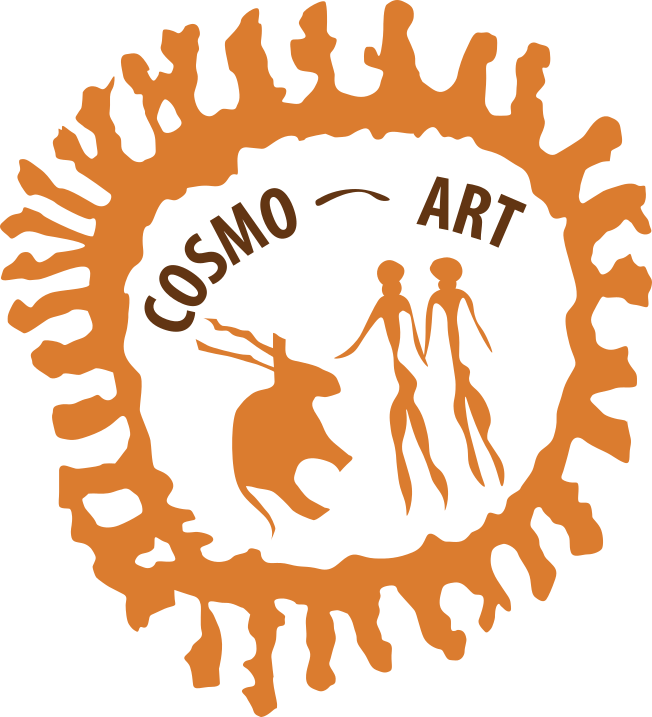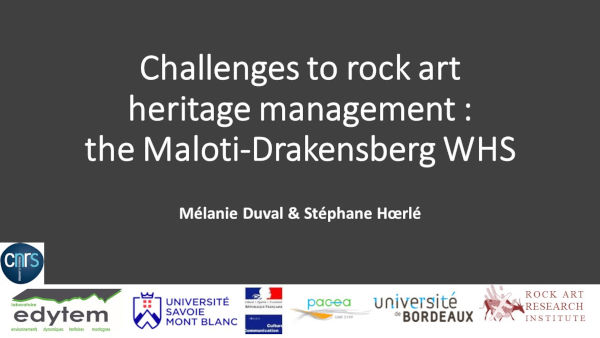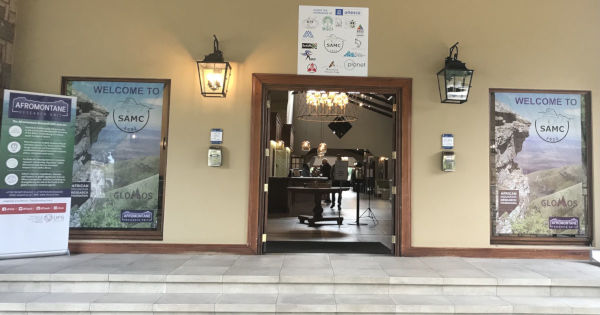Productions
Outputs of COSMO-ART include scientific communications and publications and also productions aimed at a larger audience
The aim of COSMO-ART is to renew the way of understanding the management issues of rock art sites, taking into account the diversity of uses and values attributed to them. The implementation of a cosmopolitan approach requires a broader consideration of the different stakeholders. In line with the project’s objectives, the research group is keen to disseminate the results obtained to the various stakeholders interested in the management of rock art sites, which will be done by means of communication in different formats.
2025
The Mediterranean moment of Namibian rock art, or the legitimisation of colonial presence through heritage-making (1948–1954)
Hugo Quemin, Benjamin Smith, Goodman Gwasira, David Morris & Mélanie Duval

While critical heritage studies have emphasised the need to decolonise heritage practices, the legacy of colonial-era heritage-making remains largely underexplored. This article examines the early proclamations of five rock art sites as National Monuments in Namibia during the 1950s. Through an analysis of the historical and political dynamics, alongside the involvement of leading archaeologists with colonial administrations, this study uncovers the intricate relationship between rock art heritage-making and colonial politics. For the first time, drawing on extensive archival research, it traces the emergence of Namibia’s first heritage body, the Historical Monuments Commission, and examines how rock art was instrumentalised within colonial frameworks – the appropriation of precoloniality. By revisiting this critical period, this article offers a nuanced perspective on the tensions between colonial heritage-making and contemporary decolonial efforts.
Hugo Quemin, Benjamin Smith, Goodman Gwasira, David Morris & Mélanie Duval (2025). The Mediterranean moment of Namibian rock art, or the legitimisation of colonial presence through heritage-making (1948–1954), International Journal of Heritage Studies, 1–25. DOI: 10.1080/13527258.2025.2520747
Sharing Images, Rethinking Rock Art heritage: A Photovoice Project with the !Xun and Khwe Communities of Platfontein (South Africa)
Leïla Baracchini & Mélanie Duval

This article reflects on a photovoice project carried out in 2022 with San communities in South Africa. The project is the result of a participatory and collaborative approach involving an interdisciplinary team of researchers (ANR COSMO-ART), South African academic and cultural institutions, and two local NGOs. The study took place in Platfontein (Northern Cape, South Africa), among the !Xun and Khwe war refugees from Angola and Namibia, who, in 1997, became custodians of a South African rock art site. Charged with studying the relationship between these communities and their rock art heritage, we discuss in this article how photovoice contributes to the emergence of an understanding of heritage “from below”, which differs significantly from a nationalist, touristic, and economic perspective, and instead highlights a vision of heritage rooted in people’s everyday practices and experiences.
Leïla Baracchini & Mélanie Duval (2024). Partager des images, repenser le patrimoine rupestre : un projet de photographie participative avec les communautés !Xun et Khwe de Platfontein (Afrique du Sud), Nouvelles perspectives en sciences sociales, 20(1), 135-179. DOI: 10.7202/1116924ar
2024
Claiming rock art, claiming indigeneity: Spaces and scales of recognition in Khoe and San identity claims
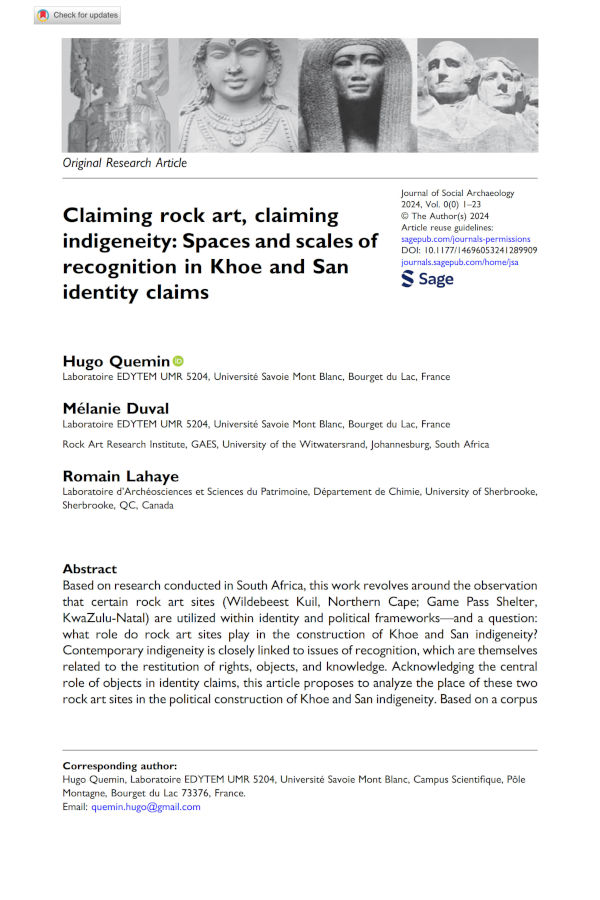
Based on research conducted in South Africa, this work revolves around the observation that certain rock art sites (Wildebeest Kuil, Northern Cape; Game Pass Shelter, KwaZulu-Natal) are utilized within identity and political frameworks—and a question: what role do rock art sites play in the construction of Khoe and San indigeneity? Contemporary indigeneity is closely linked to issues of recognition, which are themselves related to the restitution of rights, objects, and knowledge. Acknowledging the central role of objects in identity claims, this article proposes to analyze the place of these two rock art sites in the political construction of Khoe and San indigeneity. Based on a corpus of interviews, observations, legal texts, and press articles, certain uses of rock art sites will be presented as strategic means within a broader context of claims.
Hugo Quemin, Mélanie Duval, Romain Lahaye (2024). Claiming rock art, claiming indigeneity: Spaces and scales of recognition in Khoe and San identity claims, Journal of Social Archaeology, 25(1), 25-47. DOI: 10.1177/14696053241289909
2023
Exploring Multiple Conditions of Participation on Community-based Heritage Management: A Case Study of Wildebeest Kuil Rock Art Tourism Centre, South Africa
Hugo Quemin, Mélanie Duval, David Morris & Lourenço Pinto
This paper explores the limits to participation in community-based approaches (CBAs) for rock art heritage management. The construction of a tourism development project at a rock art site (Wildebeest Kuil, Kimberley, South Africa) in 2001 involved two San communities in order to provide economic and cultural support. Based on the assumption that CBAs are closely linked to participation issues, which are themselves linked to past inequalities, this article analyses the multiple obstacles to community participation despite the goodwill of managers and highlights the limits of CBAs from a critical analytical perspective. To do so, we build on qualitative data from field observations and semi-structured interviews with various stakeholders. Hence, by drawing a conceptualized framework from the Wildebeest Kuil example in CBAs for heritage management, we suggest focusing on the conditions that CBAs impose on the community participation that justify them. Finally, this article draws lines toward a sustainable perspective between CBAs and community participation, and may be transferred to other case studies.
Hugo Quemin, Mélanie Duval, David Morris, Lourenço Pinto (2023), Exploring Multiple Conditions of Participation on Community-based Heritage Management: A Case Study of Wildebeest Kuil Rock Art Tourism Centre, South Africa, Public Archaeology, 22(1), 35-59. DOI: 10.1080/14655187.2024.2355787
2022
Les enjeux de préservation et de valorisation des sites d’art rupestre en Afrique australe
Lancement du projet de recherche COSMO-ART
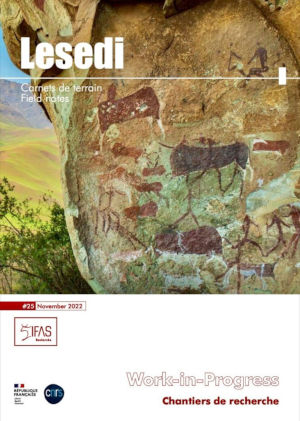
« Financé pour une durée de quatre ans par l’ANR (2022-2025), le projet COSMO-ART rassemble une trentaine de chercheurs de quatre pays (Afrique du Sud, Australie, France, Namibie) autour de la thématique suivante : analyser les enjeux de préservation et de valorisation des sites d’art rupestre en Afrique australe. Plus précisément, l’objectif est de transférer tout en approfondissant les méthodes d’observations et d’analyses développées à partir des sites d’art rupestre dans le massif du Drakensberg en Afrique du Sud en direction de deux nouvelles régions : celle de Kimberley, dans la province du Cap-Nord en Afrique du Sud et le massif de l’Erongo, comprenant l’aire de gestion des ressources environnementales de ≠Gaingu et Spizkoppe, en Namibie ……… »
Mélanie Duval (2022) Les enjeux de préservation et de valorisation des sites d’art rupestre en Afrique australe – Lancement du projet de recherche COSMO-ART, Lesedi 25, 48-54.
2023
2023
2025
Relating to Deep Time Heritage: A Photovoice Approach to San Communities and Rock Art in South Africa
Mélanie Duval & Leïla Baracchini
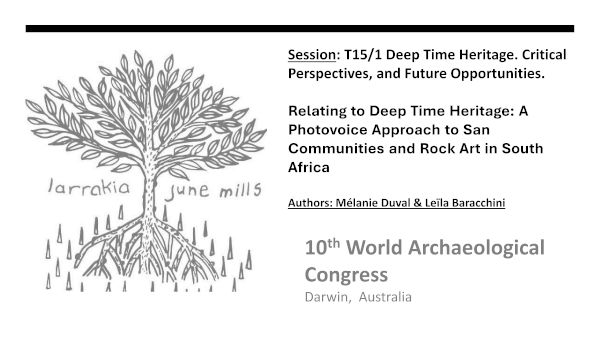
This presentation explores how present-day societies perceive Deep Time heritage, focusing on South African rock art sites. It questions whether rock art, often attributed to the San as a homogeneous group, holds significance for today’s San communities. Specifically, it examines how the Khwe and !Xun communities in Platfontein, South Africa, relate to rock art.
The Khwe and !Xun share a history of war and displacement. During Namibia’s war for independence, many were recruited into the South African Defence Force to fight SWAPO. After SWAPO’s victory in 1990, about 500 individuals and their family relocated to South Africa, eventually settling in Platfontein, a farm containing rock engravings.
Heritage institutions and tourism stakeholders have long promoted these engravings as meaningful to the San, given their ancestral origins. However, efforts to involve the Khwe and !Xun in heritage tourism at Wildebeest Kuil have not succeeded.
In the framework of an international research project called COSMO-ART, a photovoice project, reversing previous approaches, was initiated to explore heritage from their perspective. By producing images and interviews, this co-constructed research process questioned what heritage truly means to them. This presentation outlines the photovoice process, and discusses its contributions to understanding Deep Time heritage in contemporary societies.
10th World Archaeological Congress (WAC-10), Darwin, Australia, 22-28 June 2025.
Approche géographique des enjeux liés à la préservation et à la valorisation des sites d’art rupestre en Afrique australe : quels acteurs ? quels enjeux ? quelles modalités d’association des communautés locales ? Focus sur la situation namibienne

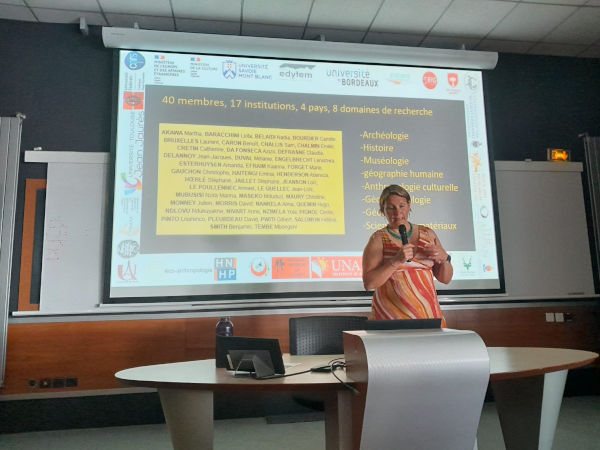
L’objectif de cette présentation est d’exposer en quoi consiste une approche géographique des enjeux liés à des sites archéologiques spécifiques : les sites d’art rupestre en Afrique australe, avec ici un focus sur la situation en Namibie. Comment ces productions graphiques, réalisées par les populations de chasseurs cueilleurs dans une période pré-coloniale, sont-elles aujourd’hui mobilisées par différents groupes d’acteurs pour servir (i) des enjeux de développement (mise en tourisme, avec dans une certaine mesure l’association de communautés) mais également (ii) des enjeux fonciers (sécurisation de la propriété des fermiers namibiens d’origine allemande dans un contexte post-colonial) ?
Séminaire découverte, Institut Néel, Grenoble, France, 13 June 2025.
From authenticity to plurality:
rethinking rock art heritage management in a
cosmopolitan perspective

This presentation aims to explore issues of authenticity and integrity in relation to rock art sites, drawing on insights from several research projects conducted over the past fifteen years in different regions of southern Africa (South Africa, Namibia). These notions, often presented as objective criteria (with « authentic » frequently equated with « genuine »), function as performative constructs: rather than merely describing the state of heritage, they impose a particular way of interpreting, managing, and valuing it. The authenticity of a rock art site is often defined according to material criteria (the preservation of paintings and/or engravings) and historical criteria (fidelity to an assumed original use or meaning), thereby steering management practices towards fixity and immutability, despite the fact that the understanding of rock art sites—whether by scholars, enthusiasts, or local users—is necessarily plural.
However, this normative reading proves problematic in the case of rock art sites in southern Africa, where these representations—whose meanings we are unlikely ever to ascertain with certainty—are reinterpreted through multiple contemporary significations and modes of appropriation. Far from being mere relics of the past, these sites are at times integrated into ritual practices, mobilised in identity discourses, or repurposed within the tourism industry. The definition of authenticity promoted by heritage institutions thus tends to reflect less the intrinsic qualities of a site than the interests of those who establish its criteria. « Authenticity itself is a chimera: its criteria shift with every change of fashion » (Lowenthal, 1997: 184). By anchoring specific management practices to a particular notion of authenticity, these heritage regimes often impose conservation approaches that may come into conflict with the uses and claims of local communities.
To move beyond this perspective, we propose a cosmopolitan approach to the management of rock art heritage, drawing on pragmatic philosophy and ontological approaches in anthropology and archaeology (Stengers, Latour, Appiah, Meskell). Such an approach does not seek to impose a single standard of authenticity but rather to acknowledge the coexistence (and entanglement) of multiple ways of relating to rock art sites. Analysing this relational complexity and the ways in which rock art heritage is appropriated, reinterpreted, and experienced in the present aims to develop management practices that respect this plurality. This presentation will focus on a methological aspect, presenting a photovoice project that have been done in Kimberley area in South Africa. Through pictures and interviews, this methodology enables to consider how people are related to heritage. This, in turn, requires a reconsideration of the normative and institutional frameworks that structure heritage policies in southern Africa, balancing international standards with management approaches that reflect local voices and attachments. By exploring situations in which the multiplicity of meanings ascribed to rock art heritage becomes apparent, we will highlight the emergence of alternative management approaches.
International Conference on Cultural Heritage in Africa – “A Dialogue on the Concept of Authenticity”, Nairobi, Kenya, 6 – 9 May 2025.
Mining the Mountains, or the Ethical Blindness of Heritage in Erongo Mountains
Hugo Quemin, Mélanie Duval, Antoine Latarge & Marie Forget
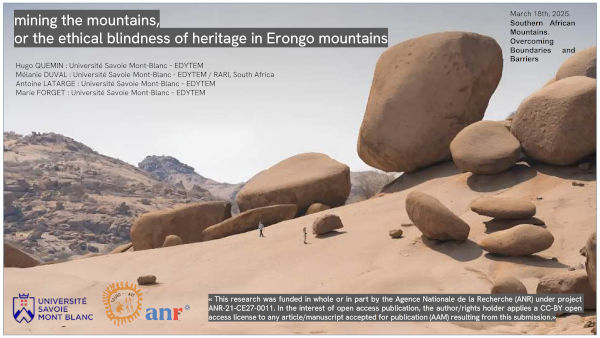
The Erongo mountains, renowned for its rich rock art heritage, has undergone significant economic transitions over the past two decades. In the early 1990s, the economy of the Erongo farms was primarily based on cattle ranching. However, by 2023, all but one of these farms had shifted their focus towards tourism, with lodges becoming the main economic driver. Concurrently, since the 1990s, the Erongo mountains has become a crucial subsistence area for many families living on surrounding communal lands. The discovery of significant semi-precious stone deposits in 1998 triggered a mining rush, attracting an increasing number of small-scale miners. Due to the rare seasonal rainfall and water supply issues, mining camps are often set up in natural shelters formed in the granite or at the base of large boulders near depressions where rainwater accumulates. Consequently, mining sites frequently border the numerous rock art sites of the massif.
Over the past two decades, several associations of large landowners in the Erongo mountains have progressively attempted to regulate this mining activity. After several failed negotiations with a Ministry of Mines unwilling to restrict farm access for mining exploration (thus permitting illegal mining activities), the landowners adopted strict contractual practices with the miners. In addition to small-scale mining activities, there is a more significant threat from potential industrial mining concessions. In this context of tension, landowners have recently begun to reconsider the value of rock art sites. In 2019 and 2024, some farms were designated as heritage sites, and other landowners plan to follow suit, aiming for the entire proclamation of the Erongo mountains. Among other interests, this proclamation is seen as the only legal means to completely prohibit mining activities. Thus, from a marginal position, rock art sites have now become the focus of active efforts to have them listed as heritage sites – the latest strategy to prevent small or large-scale mining activities in the Erongo mountains.
The heritage proclamation of the Erongo mountains would have severe consequences on the subsistence economy of small-scale miners, which is vital for many families. Although mining activity poses a potential threat to rock art sites, the heritage proclamation of these sites is revealed to be a strategy by large landowners to reinforce their control over property and maximize their tourism profits by preventing small-scale miners from obtaining mining licenses. This paper, adopting a critical perspective, proposes to explore how heritage proclamation, far from being a simple conservation measure, serves to reinforce social exclusion. It will draw on predominantly qualitative data collected between 2022 and 2024, including formal and informal interviews with key resource actors and archival data gathered from the National Archives of Namibia.
Southern African Mountain Conference (SAMC), Champagne Sports Resort (Champagne Valley, South Africa), 17 – 20 March 2025.
Coexistence between Artisanal Mining, Tourism and Environmental Protection, the (Impossible?) Dream of the Gondwanaland Geopark
Antoine Latarge, Hugo Quemin, Kaarina Efraim, Marie Forget & Mélanie Duval
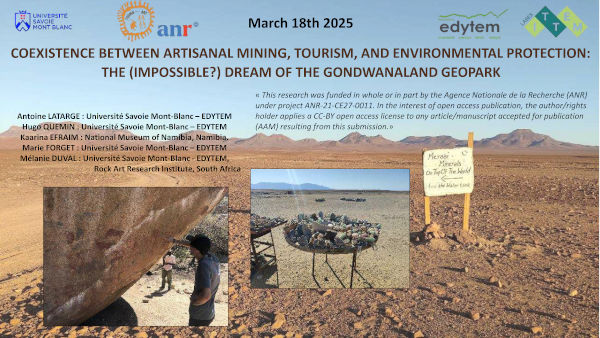
In the early 2000s, the Gondwanaland Geopark project emerged in Namibia, initiated by the Geological Survey, a branch of the Ministry of Mines and Energy. Located in the northeastern part of Namibia, straddling the Kunene and Erongo regions, this project is grounded in a spectacular geological context, exemplified by the renowned Spitzkoppe and Brandberg massifs. Additionally, the area is rich in rock art sites, such as the White Lady and Twyfelfontein, the latter of which is listed as a UNESCO World Heritage site. However, two decades later, the project has yet to come to fruition due to the absence of a legislative framework that would allow for the designation of an area as a geopark. In reality, legislative challenges are not the only obstacles to its implementation. The vastness of the proposed area, the need to bring together stakeholders at various levels, and the significant presence of more or less regulated artisanal mining activities are all factors that have slowed the project’s progress.
It is through this latter aspect, the presence of small-scale miners, that we have chosen to explore the project. This region is marked by the presence of numerous underground resources, particularly semi-precious stones (tourmaline, quartz, beryls, topazes, etc.). In a country marked by socio-economic inequalities and where the unemployment rate, especially among young people, exceeds 40%, an increasing number are turning to artisanal mining. While in most cases, the establishment of geoparks aims to exclude mining activities, the coexistence of these activities is an explicit ambition of the project’s main proponents. Fieldwork conducted in 2023 and 2024, combining observations, analysis of archival documents, and semi-structured interviews with small-scale miners and those involved in the geopark project, has allowed us to examine the issues and perceptions associated with this prospect of coexistence. Our analysis has shed light on the different imaginaries and functions attributed to the same space by various stakeholders, as well as the power dynamics that unfold among these actors as they defend—or impose—their visions of the territory. In this presentation, we will first outline the Gondwanaland Geopark project and the primary challenges it faces. Secondly, we will examine the positions of various stakeholders regarding the role of artisanal mining within the geopark and the Namibian landscape, as well as the power dynamics that emerge among them. Lastly, we will explore what these dynamics reveal about the imaginaries and values that stakeholders project onto the territory.
Southern African Mountain Conference (SAMC), Champagne Sports Resort (Champagne Valley, South Africa), 17 – 20 March 2025.
Cultural Tourism in the Erongo Mountains (Namibia): What Role for Local Communities in Rock Art Tourism?
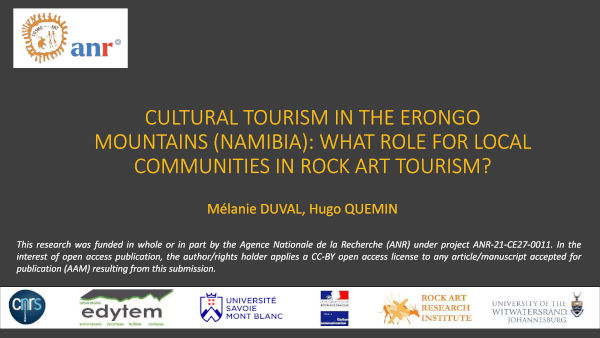
Situated 160 kilometers northwest of Windhoek, the Erongo Massif is a granitic formation, with its highest point, Mount Erongo, reaching an altitude of 2,350 meters. The massif is distinguished by its rich geological history (linked to the geological evolution of Gondwana) as well as its biological diversity, including several endemic species. It also hosts several thousand rock art sites, attributed to the San hunter-gatherer populations who inhabited the area long before the onset of German colonization. Among the numerous rock art sites in these mountains, only a few are allowed for visitor access: several sites on Omandumba West and East farms, Phillips Cave on Ameib, Paula Cave on Okapekaha, and several sites on communal lands around Tubusis. Unlike Twyfelfontein or the Brandberg mountains with the famous “White Lady” site, the rock art sites of the Erongo Massif are not managed by the state, and the guides are not affiliated with the National Heritage Council. The promotion of these sites as tourist attractions is influenced not only by land tenure but also by the way in which private owners and local communities work together. Analyzing these different cases allows for an exploration of the roles and contributions of various stakeholders.
The aim of this paper is to investigate the issues surrounding the tourism development of rock art sites in the Erongo Mountains (Namibia) from the perspective of stakeholder dynamics and local community involvement. By focusing on the main rock art sites developed for tourism, we will examine the existing forms of tourism and types of visits, as well as the actors involved and the benefits for local communities. This analysis will lead to an examination of the modes of collaboration between Namibian landowners of German descent and local Namibian communities of various origins. Finally, we will conclude with recommendations aimed at improving relations between these two main categories of stakeholders, with a view toward sustainable and equitable tourism development.
This study is based on several field campaigns carried out in 2022, 2023 and 2024. These field campaigns a combined observation phases with semi-structured interviews involving various stakeholders engaged in these tourism dynamics.
Southern African Mountain Conference (SAMC), Champagne Sports Resort (Champagne Valley, South Africa), 17 – 20 March 2025.
2024
« We just need to locate the Geopark »
Analysis of the Role of Mining Activities within a Protected Area (The Gondwana Geopark Project, Namibia)
Antoine Latarge, Hugo Quemin, Marie Forget & Mélanie Duval
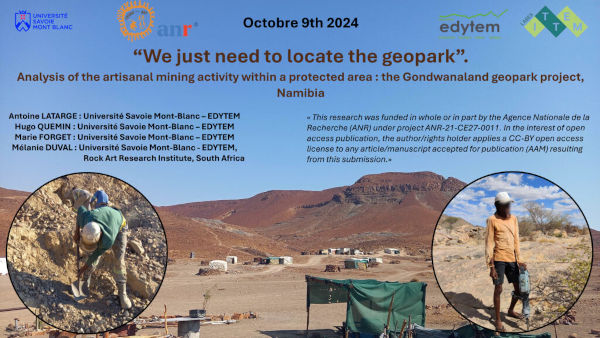
In the early 2000s, the Gondwanaland Geopark project emerged in Namibia, initiated by the Geological Survey, a branch of the Ministry of Mines and Energy. Located in northeastern Namibia, straddling the Kunene and Erongo regions, the project is set against a backdrop of spectacular geological features, such as the renowned Spitzkoppe and Brandberg massifs (Schneider, 2005). However, two decades later, the project has yet to come to fruition due to the absence of a legislative framework that would allow for the designation of an area as a geopark. The project lay dormant until it was revived a few years ago, driven by UNESCO and the German-Namibian cooperation agency (GIZ). In reality, legislative challenges are not the only obstacles to its implementation. The vastness of the proposed area, the need to engage stakeholders at various levels, the lack of integration of local communities, and the significant presence of more or less regulated artisanal mining activities all present unresolved issues that are fundamentally tied to the chosen territory. After two decades, the question of the geopark’s location— the project’s cornerstone and key element—remains under debate.
Much of the tensions revolve around the role of artisanal mining within such a space. It is important to note that artisanal mining—primarily of semi-precious stones (Nyambe & Amunkete, 2009)—serves as a crucial source of employment and income in rural areas (Odendaal & Hebinck, 2020), where the unemployment rate is particularly high (Nakuta, 2023). On the other hand, geotourism—centered around the country’s cultural, wildlife, and geological assets—presents a significant opportunity for national development (Dowling & Pforr, 2021). Thus, the establishment of the geopark must first address the resolution of several key issues: Should the originally proposed area be reduced, excluding zones that are sources of tension? Or, conversely, should the geopark be used as a tool to improve the situation for miners and thereby reduce the level of conflict? Yet, how can an activity that is inherently informal be effectively managed? Analyzing the choice of the geopark’s location reveals the different imaginaries and functions attributed to the same space by various stakeholders, as well as the power dynamics that unfold as these actors defend—or impose—their vision of the territory.
Some key references
- Brilha J. (2018). Geoheritage and Geoparks. In E. Reynard et J. Brilha (dirs.), Geoheritage: 323-335. Elsevier.
- Dowling R., Pforr C. (2021). Geotourism – a sustainable development option for Namibia. Journal of Ecotourism.
- Errami E., et al. (2015). Geoheritage and Geoparks in Africa and the Middle-East: Challenges and Perspectives. From Geoheritage to Geoparks.
- Nyambe J. M., Amunkete T. (2009). Small-Scale Mining and Its Impact on Poverty in Namibia: A Case Study of Miners in the Erongo Region. Trade & Inudstrial Policy Strategies.
- Schneider G. I.C. (2005). – GONDWANALAND GEOPARK – A proposed Geopark for Namibia. University of Namibia.
- Stewart Carter A. (2021). Hands That Dig, Hands That Feed: Lives Shaped by Coloured Gemstone Mining. The Coloured Gemstones Working Group.
Ressources du sous-sol en tension. Protection et extraction dans les territoires de montagne. Colloque international, Chambéry (France), 8-10 October 2024
A clash of interests at Canteen Kopje, South Africa: mining and the predicaments of heritage in a presentist age



In 2016 diamond mining began within a gazetted heritage site in central South Africa, impacting a unique archaeological sequence spanning the Stone Age from Acheulean basal levels, 1.7 million years old, to late nineteenth century archaeological traces of colonial contact at the surface. The mining was halted a day and a half after it began, when an urgent interdict succeeded at the Northern Cape High Court in Kimberley. Simultaneously a Review Application was launched to understand how, in the first instance, the provisions of minerals and heritage legislation had failed to protect the formally declared site. Heard at the Pretoria High Court in 2019, it was hoped that the review would help to ensure that administrative agencies abide by legal requirements to protect the nation’s heritage into the future. The ruling that was handed down endorsed the protected status of the site, and upheld the impact assessment procedures required to facilitate mining. Yet, the judgment was challenged twice as mining interests tried to overthrow the decision and continue mining the site. The latest appeal was dismissed by a full bench at the High Court in Pretoria in 2023.
A multiplicity of issues for conservation converge and are entangled in this case of heritage-in-crisis. Nor is it the only instance in which systems intended to regulate and integrate the interests of mining, development, heritage and communities have fallen short – at local, provincial and national level. In fact, less than a kilometre from Canteen Kopje, the Barkly West Museum, opened on the same day that open air displays were unveiled at Canteen Kopje, has been vandalised, stripped of fittings and fabric, after a period of municipal neglect and in the absence of heritage management structures at local government level.
Beyond the shortcomings in the implementation, and even the conception, of heritage mandates, there are broader existential conditions at play, most obviously the material conditions of poverty, where even those engaged in small scale mining for diamonds often live at or below the poverty-line (Terlien & Miller 2000).
A similarly pervasive predicament for heritage, this paper suggests, relates to a shrinking sense of the ‘present’ – an allusion to Geoff Bailey’s (2007) concept of a ‘durational present’, an ‘envelope of time’ which is afforded depth according to one’s perspective, deepened by subjects’ awareness and appreciation of historical time. For Miller (2012) a narrowed sense of ‘now’ provokes a ‘crisis of presence’ in an age of short-term, increasingly digital action, with rapid replacement of technologies, and changing modes of life. People’s sense of both ‘past’ and ‘future’ becomes attenuated and may also be impacting their experience of belonging in place and community. Not unrelated is the problem of presentism referred to by Richard Reid (2011), about the foreshortening of African history relative to a hegemonic obsession with modernity and its trappings. Reid critiques a prevailing academic view that, ‘in effect, the only history worth doing in Africa is that of the twentieth century’, and the consequences of this myopia – that the longer our earlier history is marginalised, ‘the less healthy the body politic will become, and the more troubled the society…’
There is critical work to be performed with heritage sites and museums, perhaps not so much in communicating about ‘deep pasts’ whose relevance may not be readily apparent to inhabitants of places like Barkly West today, but in giving ‘depth to the present’, integrating the past into local discourse, and salvaging a world, and an ethics of care, that is embodied, located and grounded in place. This should be part of an archaeological activism in and of the present, as advocated by Larry Zimmerman et al. (2010) who argue that archaeology can and should speak to current issues. These would include the material realities of places like Barkly West today where alluvial diamond digging in the wider district has generated little more than levelled lunar landscapes and communities still living at the margins, physically and figuratively (Terlien & Miller 2000). By countering the homelessness and the loosened grip they have on the past, people may be assisted (as Bailey urges) to appreciate not only how the past has brought us to where we are today but also how a longer future can be envisaged that is affected by actions – including the care or destruction of heritage sites – in the present.
Some key references
- Bailey, G. 2007. Time perspectives, palimpsests and the archaeology of time. Journal of Anthropological Archaeology 26: 198‒223.
- Miller, V. 2012. A Crisis of Presence: On-line Culture and Being in the world. Space and Polity 16: 265-285.
- Reid, R. 2011. Past and Presentism: the ‘precolonial’ and the foreshortening of African history. Richard Reid Journal of African History 52: 135–55.
- Terlien, D & Miller, D. 2000. Small-scale diamond mining in the Barkly West area. Unpublished report, University of Cape Town.
- Zimmerman, LJ, Singleton, C & Welch, J. 2010. Activism and creating a translational archaeology of homelessness. World Archaeology 42: 443‒454.
Ressources du sous-sol en tension. Protection et extraction dans les territoires de montagne. Colloque international, Chambéry (France), 8-10 October 2024
Le Fermier, le Mineur et l’État. Un western namibien moderne
Hugo Quemin, Marie Forget & Mélanie Duval
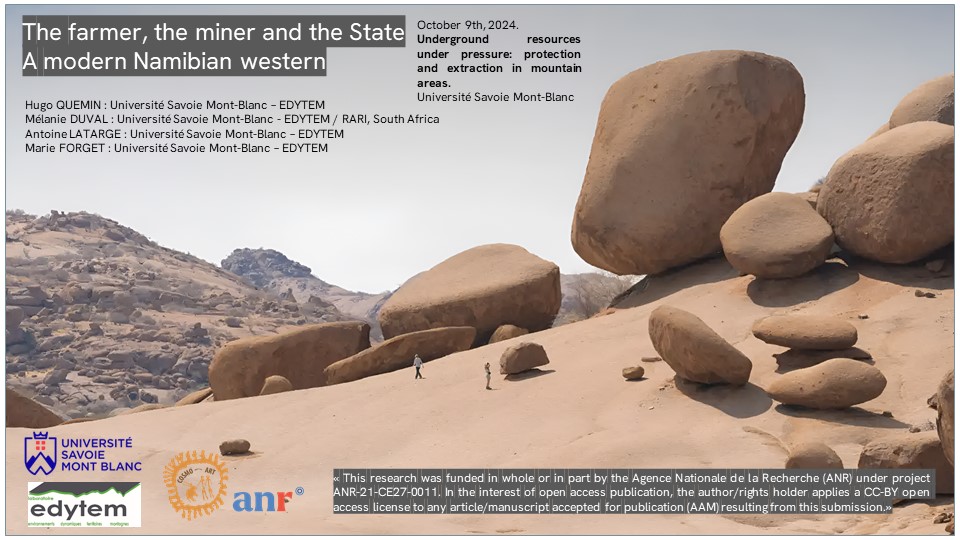
The Erongo massif, rich in rock paintings, has experienced a significant economic transition over the past two decades. While in the early 1990s, the economy of Erongo farms was mainly based on cattle breeding, in 2023, all farms, except one, have reoriented their activities towards hospitality . tourism, with lodges as the main economic driver. At the same time, since the 1990s, Erongo has become an essential place for the livelihood of many families living on the surrounding community lands. The emergence of a mining street in 1998, started with the sudden discovery of large deposits of semi-precious stones, attracted an increasing number of « small miners ». Due to rare seasonal withdrawals and water supply problems, mining camps are often installed in natural shelters formed in the granite of the massif or at the foot of large rock blocks, near depressions where rainwater flows. ‘accumulate. Thus, it frequently happens that mining extraction sites adjoin the numerous rock art sites of the massif. For two decades, several associations bringing together large land properties in the massif have gradually attempted to regulate this mining activity. After several failed negotiations with a Ministry of Mines reluctant to restrict farms’ access to mining prospecting (thus allowing illegal mining activity), the owners adopted strict contractual practices with the miners. Added to this small-scale mining activity is the greater threat of potential concessions for exploration or exploitation of industrial mines. It is in this context of tension that, recently, owners have begun to take a new look at rock art sites. In 2019 and 2024, certain farms were designated as heritage sites, and other owners plan to do the same, with the aim of obtaining complete registration of the massif. Among other interests, this registration is seen as the only legal means of completely banning mining activity. Thus, from a marginal place, rock art sites are now the center of an active demand to include them in the heritage register – the latest technique to prevent small or large-scale mining activity in the Erongo . The patrimonialization of the massif would have severe consequences on the subsistence economy of small miners, essential for many families. Although mining activity represents a potential threat to rock art sites, the heritageization of these sites appears to be a strategy of large landowners to strengthen their control over the property and maximize their tourist profits, by preventing small miners to acquire mining licenses. This communication, adopting a critical perspective, therefore proposes to explore how heritage development, far from being a simple conservation measure, is part of logics of social exclusion. It will be based on primarily qualitative data collected between 2022 and 2024, including formal and informal interviews with key resource stakeholders as well as archival data collected at the National Archives of Namibia.
Ressources du sous-sol en tension. Protection et extraction dans les territoires de montagne. Colloque international, Chambéry (France), 8-10 October 2024
An explorative study of participants’ perceptions in the « Places in Me » photovoice exhibition, in Platfontein, Northern Cape
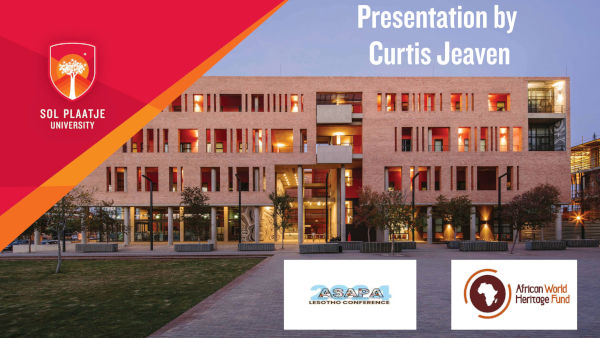
Photovoice is a method in which people utilise video and/or photography to document important environmental and social concerns to foster social change, develop a mindset of critical consciousness, and reach policy makers. This research explored the experiences of nine !Xun and Khwe participants that were involved in the 2023 « Places in me » photovoice exhibition displayed in Platfontein, Northern Cape. In 2022, Cosmo-Art partnered with two local NPOs, Southern African San Development Organisation and SAN Community Development, providing a platform for the youth of Platfontein to identify and reflect on issues through photography and citations that they perceive as important and different. The project aimed to make visible the perspectives of Platfontein’s youth by means of participants identifying issues of beauty, aspirations, suffering, disappointments and shifting identities. This dissertation adopted the concept of participatory action research using qualitative semi-structured interviews to attempt to document the personal perceptions and viewpoints of the participants. The analysis and findings from this thesis show that photovoice is an intriguing approach to challenge conventional research, more specifically to document and represent marginalised communities such as the !Xun and Khwe of Platfontein. This is evidenced by the responses from participants in view of the themes discovered by interpreting thematic content analysis.
ASAPA 2024 biennal meeting, Maseru (Lesotho), 24-28 June 2024
In search of an idea. What is « community » in « community-based management » and how to improve our understanding of it for the sake of sustainable management? !Xun, Khwe and Wildebeest Kuil rock art site
Mélanie Duval, David Morris, Lourenço Pinto & Hugo Quemin

This communication analyses the dynamics surrounding the involvement of two San communities, the !Xun and the Khwe, in the management of the Wildebeest Kuil rock art site since 2001. Despite this initiative, the !Xun and the Khwe quickly lost interest in the site. With regard to heritage resource management issues, this paper draws on this specific case study to question the uses and abuses of the notion of ‘community’. From this case study, we will see how the !Xun and the Khwe of Platfontein are sometimes considered as one community, sometimes as two communities. This matter of understanding is examined in relation to the Wildebeest Kuil rock art site. Rather than imposing preconceived ideas about what constitutes a community, this communication proposes an exploration of the dynamics surrounding this rock art site, in order to question where the community is, who makes it exist, and how it takes shape. From this rock art site, we will thus inform different existing conceptions of community (legal, anthropological), before presenting a third approach (pragmatic), one which is more realistic for our research activities, providing useful theoretical insights for action in response to cultural heritage management challenges. In terms of methods, this communication mobilises qualitative data from field observations and semi-structured interviews with various stakeholders and analysis of grey literature. It is based both on research carried out by Hugo Quemin as part of a Master’s thesis.
ASAPA 2024 biennal meeting, Maseru (Lesotho), 24-28 June 2024
What does a photovoice project contribute to the analysis of heritage management ?
A critical analysis of the « Places in Me » project with the Khwe and !Xun communities in Platfontein
Leïla Baracchini, Nadia Belaïdi, Mélanie Duval, Abenicia Henderson, Stéphane Hœrlé, David Morris, Lourenço Pinto & Hugo Quemin
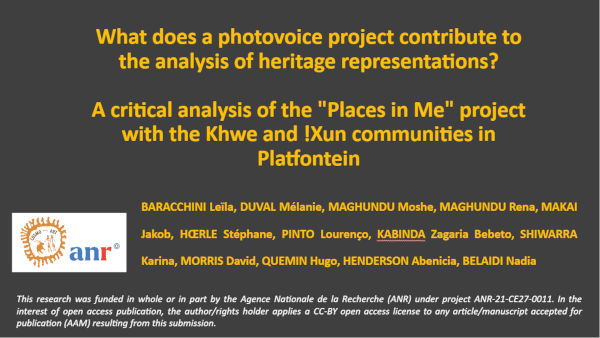
In the proposed talk, we will critically assess a photovoice project co-conducted between researchers and San communities in Platfontein in 2022 and that resulted in an exhibition (opening July 2023). This project emerged from a participatory and collaborative approach involving a multidisciplinary team of researchers (ANR COSMO-ART project), South African academics, local heritage and cultural institutions (Sol Plaatje University, McGregor Museum), and two local NPOs, SANCD and SASDO.
The project, carried out in Platfontein (Northern Cape, South Africa), involved the Khwe and !Xun communities living near the Wildebeest Kuil rock art site. The tourism industry often emphasises the spatial proximity between these two communities and rock art sites to justify their relationship. Our work sought to investigate the state of this relationship and evaluate the extent to which the rock art sites truly represent heritage for these two San communities. To achieve this, we implemented a photovoice process. Collaborating with the local NPOs, community members were invited to participate in the project and tasked with taking photos of places they deemed significant. Individual interviews based on the photos were then conducted with each participant.
Surprisingly, none of the participants took pictures of the rock art site, indicating a significant disconnect between the narratives propagated by tourism discourses and the actual state of the communities’ relationship with the rock art site.
At the same time as the photovoice process was taking place, an exhibition initiative was underway, aiming to showcase what the participants defined as their heritage, from their point of view. Selected photographs and excerpts from interviews were paired for display. The final exhibition consisted of 21 kakemonos accompanied by a booklet with texts in Xuntali, Khwedam, Afrikaans, and Setswana. In addition, a QR code system facilitated access to audio recordings of the selected quotations in the two local languages. Two opening events were held in late June/early July 2023, the first at Platfontein and the second at the SPU premises.
Moving beyond these factual details, we seek to critically examine the process implemented and assess the effectiveness of the photovoice methodology in capturing community perspectives on heritage.
This talk is largely the result of work Leïla Baracchini did during her post-doc.
ASAPA 2024 biennal meeting, Maseru (Lesotho), 24-28 June 2024
The collaboration between communities and researchers: challenges and limits. Reflection based on the « Places in me » project with the !Xun and the Khwe in Platfontein

This paper presents a collaborative project between local communities and a team of researchers on the issue of heritage. Firstly, the setting up of a photovoice project leading to the production of an exhibition will be presented. Secondly, the challenges and limits of such an approach will be examined: in the course of this process, which voices were finally heard? In the end, what lessons can be learned from this project about how best to articulate the expectations and objectives of communities and researchers with a view to shared science?
Workshop: Co-working on heritage issues with local communities, IFAS-Recherche, Johannesburg (South Africa), 12 March 2024
Uses and abuses of « community ». Lessons from Wildebeest Kuil Rock Art Tourism Centre
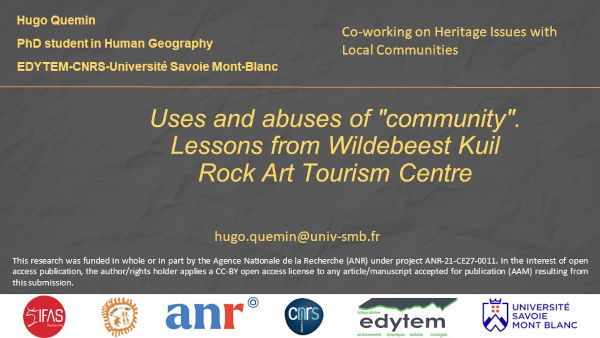
This talk aims to explain some of the reasons for the failure of a community-based approach to heritage. Based on the case of the Wildebeest Kuil Rock Art Tourism Centre, we highlight certain issues surrounding the use of the notion of « community », which end up hindering the ideal of participation justifying a community-based approach. After exploring several limits, we suggest a renewed conception of this notion.
Workshop: Co-working on heritage issues with local communities, IFAS-Recherche, Johannesburg (South Africa), 12 March 2024
In the framework of a cosmopolitical approach, what does a photovoice project bring to research on heritage-making dynamics?
Mélanie Duval & Lourenço Pinto
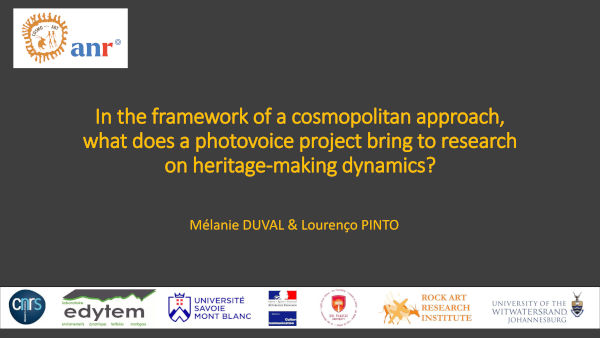
On 12 February 2024, Mélanie Duval and Lourenço Pinto presented the research conducted as part of the COSMO-ART project with the !Xun and Khwe of Platfontein, and more specifically the Places in Me project. This presentation was part of a round table organised by IFAS-Recherche entitled Academia and Communities: Experiments and Challenges in (re)Constituting, (re)Imagining and (re)Presenting Heritage in a Research Context.
This round table brought to an end an international meeting organised by IFAS-Culture on Reimagining Heritage, Archives and Museums: Today/Tomorrow (13 to 15 February in Cape Town). Following on from the discussions held in Cape Town, IFAS-Research wanted to extend the debates by organising a meeting between practitioners and researchers from different disciplines involved in heritage issues and the management of heritage issues.
The participants in this round table were:
- Zahia Rahmani (INHA);
- Neo Muyanga (Centre for the Less Good Idea) and Anna Seiderer (University Paris 8)
- Noor Nieftagodien (Wits History Workshop, University of the Witwatersrand)
- Tammy Hodgskiss, Amanda Esterhuysen & Meghan Judge (Origins Centre)
- Melanie Duval (CNRS) & Lourenço Pinto (Sol Plaatje University)
In turn, questions of heritage in a context that is both multicultural and postcolonial were addressed, with the focus on how to deal with different points of view in a South African context that is strongly marked by the history of Apartheid.
In their presentation entitled In the framework of a cosmopolitical approach, what does a photovoice project bring to research on heritage-making dynamics?, Mélanie Duval and Lourenço Pinto began by presenting the challenges of the ANR COSMO-ART project (study sites, consortium, areas of work, methodologies implemented). Emphasis was then placed on the participatory photography process put in place during Leïla Baracchini’s post-doctorate (2022-2023) and on the Places in Me exhibition that resulted from it. The presentation concluded with a discussion of the challenges and difficulties associated with this type of participatory approach.
Academia and Communities: Experiments and Challenges in (re)Constituting, (re)Imagining and (re)Presenting Heritage in a Research Context, IFAS-Recherche, Johannesburg (South Africa), 12 February 2024
2023
Entre protection et valorisation, l’accessibilité aux sites d’art rupestre

This contribution to a summer school explores the issues involved in preserving and promoting rock art sites in three ways.
Firstly, issues of accessibility to the sites are examined, looking at the way in which local players and heritage institutions manage visitor numbers. Whether the sites are in an open environment or underground, the methods of control vary greatly depending on the areas concerned and the players involved.
Secondly, we look at the criteria underlying the opening/closing of sites to the general public, with a reflexive analysis of what this means in terms of the heritage process. What criteria are put forward to justify the closure of a site? To what extent is the variability and relativity of the criteria invoked relevant to understanding what is at stake in terms of heritage values?
Finally, the issues concerning rock art sites in southern Africa are examined, as well as how they relate to different uses and registers of value.
Encuentro El nuevo MUPAC: investigación, conservación e interpretación del patrimonio arqueológico en el siglo XXI, Santander (Spain), 17-18 Augut 2023.
2022
Partager des images, repenser le patrimoine rupestre : un projet de photographie participative avec des populations san d’Afrique du Sud
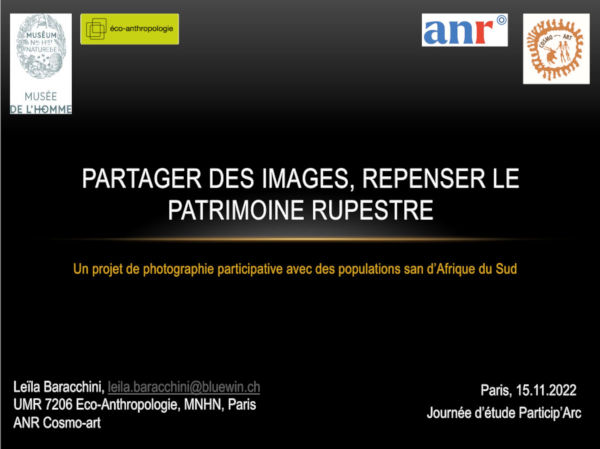
Il est devenu ces dernières années de plus en plus fréquent d’engager des chercheurs en sciences sociales dans des programmes d’étude, de gestion et de protection de patrimoines archéologiques. Ce type de collaboration vise souvent à répondre aux demandes internes et/ou institutionnelles d’implication des communautés locales dans la gestion des sites archéologiques dans le but notamment de diminuer les frictions qui peuvent émerger de la cohabitation avec des biens patrimoniaux (benefice-sharing, empowerment). C’est dans une telle perspective qu’a été initiée l’ANR Cosmo-art : The Cosmopolitan approach as a new paradigm for rock art heritage management in Southern Africa, un projet de recherche interdisciplinaire avec pour objectif de favoriser la mise en œuvre d’une gestion intégrée et durable des sites rupestres à partir d’une étude croisée des valeurs associées au site par l’ensemble des stakeholders.
Pour répondre à ces objectifs, un projet de photographie participative (photovoice) et d’exposition en collaboration avec les communautés san, !Xun et Khwe, de Platfontein (Northern Cape, Afrique du Sud) a été mis en place. Originaires d’Angola et de Namibie, ces populations ont été relocalisées en Afrique du Sud à la fin de la guerre d’Indépendance en Namibie et sont devenues en 1997 propriétaires du site d’art rupestre de Wildebeest Kuil. Elles ont ensuite été associées au projet de développement du site et `a son ouverture au public en 2000. Vingt ans plus tard, toutefois, l’idéal initial d’implication des communautés dans la gestion et les bénéfices de Wildebeest Kuil ne semble avoir que très partiellement abouti, le rapport des deux communautés au site étant aujourd’hui des plus distants.
Cette contribution reviendra sur les diverses étapes de collaboration et de négociation menées autour des projets de photographie et d’exposition avec les participants à l’étude, deux ONGs locales ainsi que plusieurs institutions culturelles et universitaires de la région. Il s’agira notamment de réfléchir aux intérêts croisés qui motivent ce type de projet et de discuter des apports, des effets et des limites d’une telle approche pour saisir, rendre visible et questionner le rapport au patrimoine et au territoire dans un contexte marqué par des enjeux de relocalisation, d’autochtonie et de très fortes inégalités sociales et économiques. Je montrerai en quoi cette démarche participative modifie le rapport entre chercheur et participants à l’étude, crée de nouvelles alliances et amène à mettre en débat une certaine conception du patrimoine. Enfin, si la photographie participative est souvent mise en avant comme une méthode favorisant l’engagement, l’échange, l’action politique et la restitution, cette contribution montrera comment les acteurs et les dynamiques institutionnelles en jeu dans le processus de recherche peuvent à la fois renforcer et mettre à l’épreuve ces idéaux méthodologiques.
1st Young Researcher’s Day Participative Cultural Research, Particip-Arc, Paris (France), 16 November 2022
« Giving » voice, sharing pictures and rethinking heritage
A photovoice project with displaced San communities (Kimberley, South Africa)
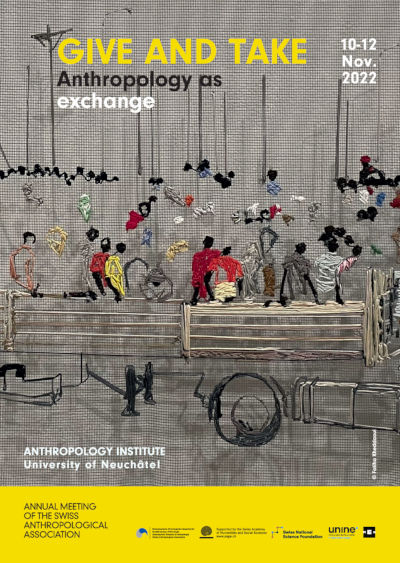
In recent years, it has become increasingly frequent to involve social sciences in programmes for the study, management and protection of archaeological heritage. This type of collaboration often aims to respond to internal and/or institutional demands for local communities involvement in cultural heritage management with the aim notably to analyse the dissonances at play in the management of heritage and to explore the possibilities of dialogical negociations and consultations within power-charged relationships. It is in this perspective that the ANR COSMO-ART: The Cosmopolitan approach as a new paradigm for rock art heritage management in Southern Africa was initiated. Based on a cross-study of the values associated with rock art sites by all stakeholders, this interdisciplinary project eventually seeks to develop an integrated and sustainable management approach.
To meet these objectives, a participatory approach (photovoice) and an exhibition project was initiated in collaboration with the two San communities, !Xun and Khwe, who own today the rock art site of Wildbeest Kuil (Northern Cape, South Africa). Drawing on this experience, this contribution will focus on the values, effects and limits of using a photovoice approach to capture and make visible the relationship to heritage and territory in a context marked by issues of relocation, autochthony and strong social and economic inequalities. I will show how this participatory approach modifies the relationship between the researchers and the participants in the study, creates new alliances with private and public organisations (such as museum, NGOs and foundations) and puts into debate conceptions and knowledge on heritage. Finally, if Photovoice is often put forward as a method favouring engagement, exchange, political action and restitution, this contribution will show how the actors and institutional dynamics at play in the research process may both reinforce and challenge these methodological ideals.
Annual Meetings of the Swiss Anthropological Association (SAA), “Give and Take – Anthropology as Exchange”, Neuchâtel (Switzerland), November 10-12, 2022
The tourism development of a rock art site in the Kimberley region (South Africa): genesis, issues and limits of a community-based approach
The communication is entitled « The tourism development of a rock art site in the Kimberley region (South Africa): genesis, issues and limits of a community-based approach ». It examines the relations between two San communities (!Xun and Khwe of Platfontein) and the public institutions on which the development of tourism and the management of a rock art site in South Africa depend. Based on semi-structured interviews, questionnaires and two and a half months of observation, this communication describes 1) the circumstances of the failure of a rock art tourism project, 2) the contemporary politico-cultural issues surrounding rock art and 3) the struggle for visibility in a post-apartheid context.
7e Rencontre des études africaines (REAF), Toulouse (France), 28 June – 1 July 2022.
De réfugiés à propriétaires de site archéologique
Quelle relation au patrimoine rupestre pour les !Xun et les Khwe de Platfontein (Kimberley, Afrique du Sud)?
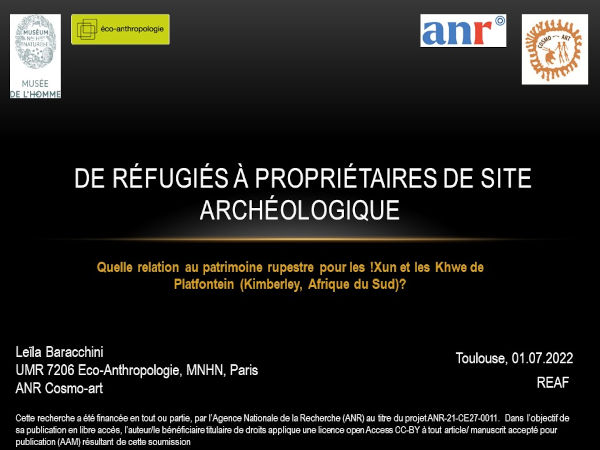
La relation entre art rupestre et populations san s’est imposée ces dernières années comme une évidence en Afrique du Sud. Comment alors comprendre lorsque cette relation ne se fait pas et comment venir explorer et mettre en mot cette absence ? À partir d’une étude menée au près des !Xun et Khwe de Platefontein, cette contribution discutera de l’intérêt d’une approche par photoélicitation pour appréhender les paysages du quotidien, saisir les enjeux qui leur sont associés et rendre visible d’autres narratifs autour du patrimoine rupestre.
7e Rencontre des études africaines (REAF), Toulouse (France), 28 June – 1 July 2022.
Les apports de l’approche géographique dans l’analyse du processus de patrimonialisation des sites d’art rupestre en Afrique australe
Enseignements à parir des sites d’art rupestre dans le massif du Drakensberg
Cette contribution vise à discuter des apports de la géographie humaine dans l’analyse des dynamiques patrimoniales. En m’appuyant sur les sites d’art rupestre situés dans le massif du Drakensberg, l’objectif sera de présenter les données et les méthodes utilisées, et in fine, de discuter de la pertinence de cette entrée disciplinaire pour 1/ comprendre les dynamiques socio-spatiales par lesquelles des lieux deviennent du patrimoine, 2/ appréhender des jeux d’acteurs et 3/analyser les choix inhérents à tout processus de patrimonialisation.
7e Rencontre des études africaines (REAF), Toulouse (France), 28 June – 1 July 2022.
Challenges to Rock art Heritage Management in the Southern African Mountains: the Maloti-Drakensberg World Heritage Site, Lesotho/South Africa.
Mélanie Duval & Stéphane Hœrlé
This paper focuses on the cultural dimension of the mountains of southern Africa, and questions the issues of valorisation and sustainable management of emblematic archaeological sites: the rock art sites. In the same way as the discovery of landscapes, fauna and flora, the rock art sites constitute resources for tourism in the mountains of southern Africa, capable of generating forms of local development. These sites bear witness to the dynamics of settlement and appropriation of the massif by different socio-cultural groups (Khoisan- and Bantu-speaking people), and are today marked by differentiated uses, combining domestic, traditional and spiritual uses, and tourist uses with different forms of development. This diversity of uses is matched by a diversity of values attributed by the different stakeholders. Consequently, one of the main challenges for the managers in charge of the tourism development of these sites is to think of a global and integrated approach, making it possible to take into account the variety of uses present and the values attributed while guaranteeing the preservation of rock art sites over time.
Focusing on the Maloti-Drakensberg mountains, this paper proposes, according to both a diachronic and synchronic approach, to analyse (i) the way in which rock art sites are put into tourism in the massif and (ii) to what extent their management plans take into account the diversity of their uses. In the third part, the analysis will focus on the issues and limits identified, with a methodological reflection on the interest of the cosmopolitan approach to think about sustainable tourism of rock art sites in the Southern African mountains.
To this end, this paper will draw on the results of research undertaken in the Drakensberg since 2009 (see below for a list of publications relating to this case study) with a cross-sectional analysis of data collected over the last ten years: field observations, interviews with institutional actors, tourism stakeholders and local populations, analysis of reports and management plans. The discussion on the interest of the cosmopolitan approach will present the main lines of the COSMO-ART research project, funded by the French National Research Agency (ANR) from 2022 to 2025, whose main objective is to advance on a methodological level in order to think of sustainable management methods for rock art sites in Southern Africa. The COSMO-ART research project involves several partners in France (EDYTEM, MNHN, PACEA, TRACES, IFAS), South-Africa (RARI, Origins Centre, SARADA, Sol Plaatje University & McGregor Museum, SANParks), Namibia (University of Namibia, National Heritage Council, National Museum of Namibia) and Australia (Centre for Rock Art Research + Management, University of Western Australia).
Southern African Mountain Conference (SAMC), Champagne Sports Resort (Champagne Valley, South Africa), 14 – 17 March 2022.
2024
Understanding the management of rock art sites and stakeholders engagements in South Africa and Namibia: Wildebeest Kuil, Kimberley and Spitzkope Namibia
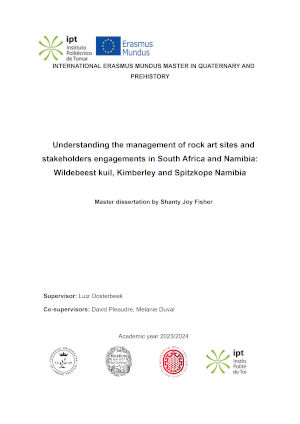
Shanty carried out the research presented in this dissertation to obtain her degree from the Erasmus Mundus International Master in Quaternary and Prehistory.
Understanding the management of rock art
sites and stakeholders engagements in South Africa and Namibia: Wildebeest Kuil, Kimberley and Spitzkope Namibia
This dissertation assesses the engagement of stakeholders in the management of rock art sites in Southern Africa, through an analytical comparative study of the different site management plans of two relevant prehistoric rock art sites: Wildebeest Kuil rock art site in the Northern Cape, South Africa and the Spitzkope rock art at the Erongo Mountains, in Namibia. Thus including understanding the site management and stakeholders engagements. The dissertation analysed data from grey literature, secondary sources, field community engagements as well as site documentation through a thematic content analysis. The key discussion point of the study looked at the relevance of by the involvement of the community for the various dimensions of the management of these sites. These included considering the different stakeholders such as the National heritage councils, various institutions concerned with heritage and rock art sites in Southern Africa, as well as local communities. The outcomes of the research and data collection have showed that indeed the involvement marginalised and lower social status communities is important for the management of the studied sites.
2023
Conservation of Wonderwerk Cave Paintings (Northern Cape, South Africa)
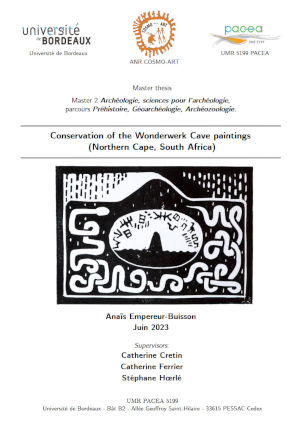
This dissertation presents the research Anaïs carried out to obtain her Master 2 degree in Archaeology & Science for Archaeology, specialty in Prehistory Geoarchaeology and Archaeozoology, at the University of Bordeaux.
Conservation of Wonderwerk Cave Paintings (Northern Cape, South Africa)
This work addresses the conservation of Wonderwerk Cave’s paintings (Northern Cape Province, South Africa). Very few studies focused on this point, yet a conservation study is essential to ensure the rock art durability, and is an essential prerequisite to eventually get meaning out of the art.
We thus made a condition assessment of the paintings, by identifying and recording the different weathering forms and their relations to the rock art. To do so, we studied the rock art area in its entirety, from its geological setting to the wall facies. We identified the different weathering forms impacting the rock art, using chemical analysis when necessary. The relations between the weathering forms and the rock art were recorded in detail in two chosen study zones. In parallel, we monitored the weathering factors in the cave, in order to understand and quantify their impact on the walls.
This work enabled us to calculate a dangerousness index, and to make recommendations regarding conservation measures and future monitoring of the cave.
Heritage as translation. Past and present perspectives on the making of rock heritage in Namibia.
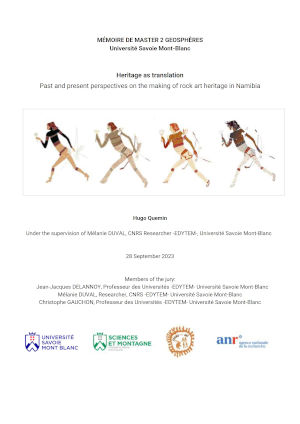
This is the outcome of Hugo’s research project carried during Master 2 degree Géospheres, at the University of Savoie Mont Blanc
Heritage as translation. Past and present perspectives on the making of rock art heritage in Namibia.
Based on six weeks of fieldwork, this dissertation aims to provide an account of the close links between heritage experience and the heritage-making process. The first part of this work examines how the notion of « heritage » encodes different conceptualizations, each reflecting singular experiences of the world. Emphasizing the importance of communication and conceptual expertise in the construction of heritage experience, we suggest studying the acts of translation that precede heritage-making. This perspective is illustrated by two geographical case studies. The first draws on an extensive archival collection to trace in detail the context of the first inscriptions of rock art sites in Namibia between 1950 and 1954. The second study is based on interviews and observations to examine in detail the context of the current inscription process for rock art sites in Namibia’s Erongo Massif. Throughout the dissertation, the act of translating heritage experience is interrogated, either explicitly through a conceptual examination of the elements that influence it, or implicitly through an analysis of the contexts in which heritage processes take place. Ultimately, this dissertation, situated at the crossroads of disciplinary fields, offers a new space of exploration for apprehending some of the issues at stake in heritage studies.
2022
Gazes on heritagity. The tourism construction of a rock art site in the Kimberley region (South Africa): genesis, issues and limits of a community-based approach to management and reflections on the socio-political issues of archaeology.
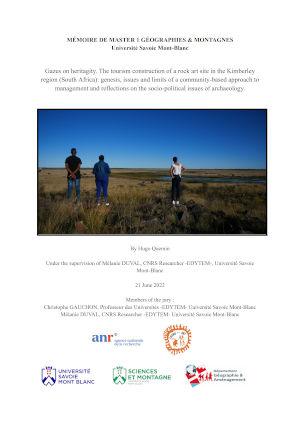
This dissertation is the outcome of Hugo’s research project carried out for obtaining his Master 1 degree in Geography & Mountains, at the University of Savoie Mont Blanc.
Gazes on heritagity. The tourism construction of a rock art site in the Kimberley region (South Africa): genesis, issues and limits of a community-based approach to management and reflections on the socio-political issues of archaeology.
This research, which follows three months of fieldwork, is articulated on the basis of an observation – the Wildebeest Kuil rock art site (Northern Cape, South Africa) is rarely visited – and on the question: what contemporary issues revolve around the site? The construction of an interpretive centre on the edge of Wildebeest Kuil in 2001 was undertaken to provide economic and cultural support to two San communities displaced and resettled at the same time near the site. Supported by new South African heritage management rules in 1999 and with a view to integrating the Xun and Khwe communities into the management of the rock art site, the Wildebeest Kuil Rock Art Centre is an example of community-based tourism of archaeological heritage. However, the lack of tourism has not led to the establishment of sustainability at Wildebeest Kuil. The author analyses at length the multiple causes of this marginality despite the good tourist numbers and the interest in cultural heritage in the destination where the site is located (Kimberley). Throughout the dissertation, the community-based approach is questioned either directly, by analysing in depth the failure of this mode of management at Wildebeest Kuil, or by proposing to shift the focus to the contemporary issues of the communities on the site and to the cultural and political perspectives benefiting from the development of tourism at the site. Therefore, this research proposes to observe the complexities surrounding the development of tourism by proposing a progressive conceptualisation and generalisation of the example of Wildebeest Kuil in the management of archaeological sites in South Africa. On the basis of a study of various expectations on the site and mainly from qualitative data, this work proposes in fine to underline the fundamentally social issues of archaeology in South Africa by using and adapting a methodology inherited from critical heritage studies.
